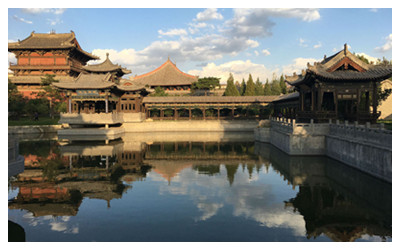- Home
- China Provinces Guide > Shanxi > Shanxi Attractions >
Datong Shanhua Temple

Shanhua Temple is located within 2 kilometers from
Huayan Monastery and
Nine-Dragon Screen of Datong City in Shanxi Province. It has the best-preserved extant layout of the Liao (907 - 1125) and Jin (1115 - 1234) Dynasties in China. It was also called the Southern Temple (Nan Temple). The temple was originally built during the Tang Dynasty (618 - 907) but it was destroyed by war at the end of the Liao Dynasty. During the Jin Dynasty it was rebuilt on a large scale.
Covering an area of over nearly 14, 000 square meters, Shanhua Temple has three main buildings on the north-south axis: the Main Gate, the Hall of the Three Saints and the most important building, Mahavira Hall (Da Xiong Bao Dian). To the west of the Hall of the Three Saints lies the Puxian Pavilion. Kwan-yin Pavilion and Ksitigarbha Pavilion are situated on the two sides of Mahavira Hall.
When visiting the temple, visitors first come to the Five-Dragon Screen. It is made of colored glaze. There are eight nice dragon screens in Datong and this is one of them. The Five-Dragon Screen was first at Xingguo Temple (another famous temple in Datong) and was moved to this temple in 1980. It is around 20 meters long and 7 meters high, with five vivid dragon signs on it. It adds a trace of cheerful atmosphere to the temple. The dragon in the middle stares at the gate of the temple.
The gate to which the dragon looks is the Main Gate. It is actually an entrance hall of the temple. Four Heavenly Kings’ statues are placed in this hall on two sides. Its length is around 27 meters and width is 10 meters. Built between 1128 and 1143, it is one of the biggest gates among the temples built in the Jin Dynasty.
The Hall of the Three Saints, built based on a one-meter high terrace, is located in the middle. It is a typical wooden architecture of the early Jin Dynasty. It is about 28 meters long and 13.5 meters wide. This hall houses three main statues representing Sakyamuni, Bodhisattva Puxian and Bodhisattva Wenshu - the Three Saints of Huayan Sect in Buddhism and some statues plus two stone tablets on which the temple’s history is recorded.
Along the way to Mahavira Hall, one can see two side halls – the Pavilion of Bodhisattva Puxian on the west and the Pavilion of Bodhisattva Wenshu on the east. The Pavilion of Bodhisattva Wenshu was destroyed in the early 20th century and rebuilt by local government in 2008. The Pavilion of Puxian was also rebuilt in 1154, following its original style of Liao Dynasty. It has three floors inside, but only two floors can be seen from outside.
The Mahavira Hall is the biggest and the main hall of this temple. It is the only architecture of Liao Dynasty that was not damaged by the years of the war. The hall accompanied by a memorial archway and bell as well as drum pavilions are built on an 3.3 meters high terrace. It is about 41 meters wide and in it resides five gold-coated statues of Tathagata Buddha, called Wu Fang Fo, which are original statues from the Jin Dynasty. On the eastern and western sides of these five statues, there are 24 gods, beautifully and realistically shaped. Among them, the statues of the God of the Sun's Palace and the God of the Moon's Palace are artistic masterpieces from the Jin Dynasty. Some pictures describing Buddhism stories are painted on the west and the south walls.
Travel Tips
Add: within 2 kilometers from Huayan Monastery and Nine-Dragon Screen of Datong City in Shanxi Province.
Entrance Fees: CNY 50
Opening Hours: :08:00-17:00
 Shanhua Temple is located within 2 kilometers from Huayan Monastery and Nine-Dragon Screen of Datong City in Shanxi Province. It has the best-preserved extant layout of the Liao (907 - 1125) and Jin (1115 - 1234) Dynasties in China. It was also called the Southern Temple (Nan Temple). The temple was originally built during the Tang Dynasty (618 - 907) but it was destroyed by war at the end of the Liao Dynasty. During the Jin Dynasty it was rebuilt on a large scale.
Shanhua Temple is located within 2 kilometers from Huayan Monastery and Nine-Dragon Screen of Datong City in Shanxi Province. It has the best-preserved extant layout of the Liao (907 - 1125) and Jin (1115 - 1234) Dynasties in China. It was also called the Southern Temple (Nan Temple). The temple was originally built during the Tang Dynasty (618 - 907) but it was destroyed by war at the end of the Liao Dynasty. During the Jin Dynasty it was rebuilt on a large scale. Ask Questions ?
Ask Questions ?